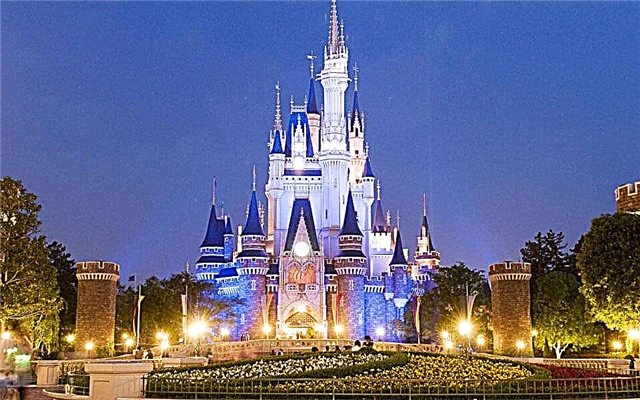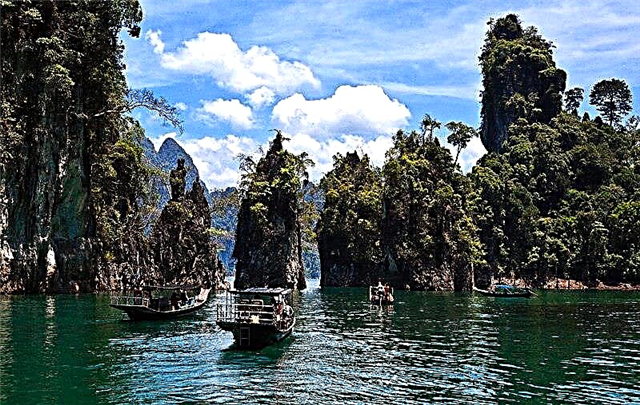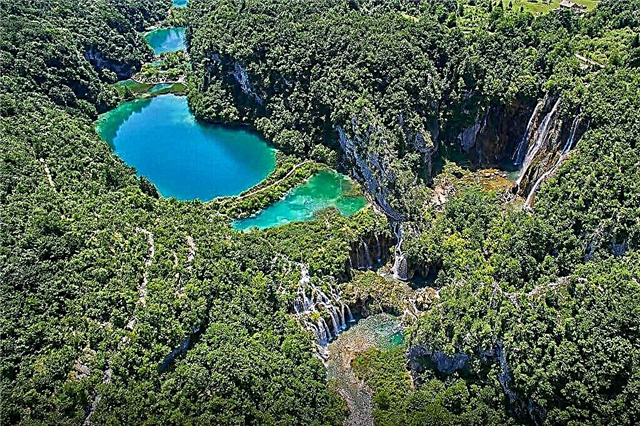As an independent country, Croatia appeared on the map of Europe quite recently - in 1991. In the past, the territory of the state was under the control of the Romans, French and Austro-Hungarians, and was part of Yugoslavia. Significant places and objects remained from each era. The historical centers of Dubrovnik, Rovinj and Trogir will allow you to get acquainted with the history of Croatia to the fullest. There are many buildings that are included in the UNESCO World Heritage List.
The unique modern facilities include the Zadar Sea Organ, which is used for open-air concerts by the sea and the wind. The most beautiful beach in the country is the Golden Horn, located on a spit protruding into the sea. And national parks like Mljet are practically untouched natural beauty with rich tourist potential.

The best hotels and hotels at affordable prices.
from 500 rubles / day
What to see and where to go in Croatia?
The most interesting and beautiful places for walking. Photos and a short description.
Dubrovnik
The walled city is sandwiched between rolling hills and the sea. Dubrovnik was founded in the 7th century, and some of the arches, churches, towers that have survived to this day were built around this period. The fortress walls stretch for 2 km. The height reaches 25 meters and the width is 6 meters. They seem to grow out of the rocks, turning the city into a sea fort with full-fledged defensive fortifications. The walls acquired their present appearance in the 16th century.

Plitvice Lakes
This protected area is located in the central part of the country. The complex of lakes was included in the UNESCO World Heritage List in 1979. The water is so transparent that you can see the bottom and fish, of which there are many. Swimming is prohibited, as well as disturbing the natural balance of a natural attraction in any other way. From time to time new waterfalls appear in the valley. Now there are about 140 of them.

Pula amphitheater
One of the largest surviving Roman amphitheaters. In the past, it accommodated about 23 thousand people, now - 5 thousand. Until the 5th century, battles were fought within the walls of the majestic structure. Gradually, bloody battles crowded out fairs and other city events. A museum has been opened in the underground halls of the amphitheater. The main exhibits are archaeological finds that tell the history of these places.

Rovinj
Most of the houses in the Old Town of Rovinj were built in Mediterranean style over 100 years ago. Another important difference is the bright colors of the outer walls. In 1963, these quarters were officially named a cultural monument, and attractions are literally around every corner. Three gates have also survived: the Portico, the Mutual Gate and the Gate of St. Benedict. They are an integral part of the fortress wall that once surrounded the city.

Trogir
Under each ruler, Trogir, located on the Adriatic coast, continued to develop, decorate and follow fashion. For this reason, the mixing of styles on its streets is a familiar sight. Renaissance and Baroque buildings coexist with Romanesque churches, and the local cathedral is a true piece of architectural art. The historical center of Trogir is included in the UNESCO World Heritage List.

Korcula
This city, based on the island of the same name, is called the most "Venetian" on the Adriatic coast. It is easy to reach by ferry: they leave from different ports in Croatia. In winter, the resort is empty, and in summer it fills up with holidaymakers. The houses are characterized by decorations in the form of generic emblems, balconies and passages. The city walls date back to the 13th century, but acquired their present appearance after numerous restorations and rebuildings.

Diocletian's Palace (Split)
Built in Split at the turn of the 3rd and 4th centuries. For its construction, materials brought from Turkey and Egypt were used. It is included in the list of UNESCO World Heritage Sites as the best-preserved palace of the Roman Empire. The central building is rectangular in shape and resembles the camp of the Roman legion. Under him there were temples in honor of Jupiter, Wiener and Cybele. The mausoleum is well preserved.

Euphrasian Basilica (Porec)
Part of a vast architectural complex in the town of Porec. The basilica bears the full name of the "Assumption of the Blessed Virgin Mary" and has the status of a cathedral. Mosaic tape frames the front of the snake. The front wall is decorated with mother-of-pearl inserts on stone slabs. The canopy over the altar was created in the 13th century from marble, and the canopy is supported by columns and is also decorated with mosaics.

Hvar fortress
Built in the 16th century on a hill. It was rebuilt under different rulers. The period of Austrian rule was especially significant in terms of changes in appearance. An observation post and barracks appeared in the fortress. The halls house a collection of amphorae, as well as artifacts dating from the Middle Ages and earlier eras. The walls offer a picturesque view of the Pakleni Islands and Hvar.

Lovrienac Fortress (Dubrovnik)
The construction of a fortress near Dubrovnik was necessary for defense. The cannons installed on the walls of Lovrienac controlled all approaches to the city from land and sea. The fortress became a continuation of the 40-meter hill, which increased the view for the guards. The thickness of the walls varied from 60 cm to 12 meters. This was done in case of the capture of the fortress: several volleys from the direction of Dubrovnik would return the territory under Croat control.

Temple of Augustus (Pula)
Refers to the Roman period of government. The temple was built in Pula in honor of the emperor Augustus. It was part of a triad - a complex of similar structures that has not survived to this day. Initially, pagan gods were worshiped here. Over time, the temple came under the auspices of Christianity. After restoration in the middle of the last century, the sights returned to their former appearance, and inside they arranged a permanent exhibition of bronze and stone sculptures.

Ban Jelacic Square (Zagreb)
The central square of the Croatian capital. Named after the Austrian commander who was of Croatian origin. He held the title of ban - the ruler of the country for 11 years. The square was laid out in the 17th century and was called Kharmita. The area is closed to cars, but many tram routes intersect here. Attractions nearby: the first high-rise building in Zagreb, the building of the country's largest bank, the Mandushevac fountain.

Croatian National Theater (Zagreb)
The theater premises acquired their present appearance in the 60s of the last century, and the cultural center itself was founded in the 19th century. Viennese architects were responsible for the design of the building. This is the main theater and opera stage in the country. Actors, singers, musicians and conductors of world renown performed there. Among them are Ivan Zaits, Sarah Bernhardt, Franz Liszt. In 1995, the centenary of the theater was widely celebrated.

Museum of Broken Relationships (Zagreb)
Also referred to as the "Museum of Divorce". In 2011, the Zagreb landmark received a prize from the European Museum of the Year award. The founders of the collection are Olinka Vishtitsa and Drazen Grubisic. These artists were once a couple, and after the breakup they decided to keep the memorabilia - a symbol of their happy past. Gradually, the exhibition was supplemented with exhibits provided by other ex-lovers.

Oceanarium Pula
In 2002, the Austro-Hungarian fortress of Verudela was given to the Oceanarium. An architectural landmark built in 1886 was restored and adapted for new needs using the latest technology. Among the inhabitants of aquariums are representatives of the Adriatic Sea, guests from the tropics, freshwater fish of European lakes and rivers. The largest aquarium is a shark house. Since 2006, the Sea Turtle Rescue Center has been operating at the Oceanarium.

Sea organ (Zadar)
Not far from the port in Zadar, stone steps stretch for 70 meters along the embankment. They are the topside part of the sound system, which also includes 35 polyethylene pipes. Different diameters and lengths, as well as angles of inclination allow the force of the sea water to drive air through the structure and get the sound of wind instruments. The architect of the landmark is Nikola Basic.

Church of St. Mark (Zagreb)
One of the oldest buildings in Zagreb. It is located on the square of the same name near the parliament building. Fires and earthquakes are the reasons for the constant rebuilding of the church in the past. The architecture can be traced to Romanesque, Gothic and Baroque styles. The interiors are decorated with frescoes depicting members of the royal family. On the tiled roof of the church, there are two coats of arms: the triune kingdom that once existed on the territory of Croatia and the capital itself.

Zagreb Cathedral
The end of the XI century is considered the time of foundation. Built in honor of the ascension of the Virgin Mary and two saints: Vladislav and Stephen. Centuries later, walls appeared around the cathedral. The South Tower was used as a military observation post in the 17th century. The presbytery became the burial place of the commander Erdodi and the cardinal Stepinats. In 1993, the image of the landmark was featured on the 100 kuna banknote.

Split Cathedral
Split Cathedral is the oldest functioning cathedral in the world. The former imperial mausoleum is the basis of the cathedral. And the whole complex can be conditionally divided into three parts, which were built in different eras. The Catholic landmark is located on the territory of the Diocletian Palace. Numerous reconstructions did not touch on some details: the wooden doors, the Gothic altar, the crypt and the relics.

Church of St. Euphemia (Rovinj)
Founded in the first half of the 18th century. Earlier on this site in Rovinj stood the Church of St. George, but it has become too small for parishioners arriving from all over the area. A bell tower was built nearby - a simplified copy of a similar Venetian bell tower, belonging to the Cathedral of St. Mark. The sarcophagus with the relics of Euphemia is placed behind one of the altars. Marble was actively used in the interior decoration of the church.

Cathedral of St. James (Sibenik)
The construction took more than a hundred years and was completed in 1536. The height of the dome is 32 meters. 74 sculptures surround the altar from the outside. Statues of Old Testament prophets adorn the baptistery. The cathedral has the status of a cathedral in the city of Sibenik. It is one of the seven Croatian churches called "small basilicas". Since 2000 it has been included in the UNESCO World Heritage List.

Mirogoj cemetery (Zagreb)
One of the most beautiful cemetery parks in Europe. Created in Zagreb in 1876. The central building of the complex is the Peter and Paul Chapel. Its architect is Hermann Bolle. Prominent Croats of different denominations are buried in the cemetery. In addition to individual graves, there are several memorials here. Among them are the Monument to Yugoslav National Heroes and the Wall of Pain, dedicated to the victims of the war for the country's independence.

Baredine cave
Lime water made the cave near the city a real work of art: stalactites and stalagmites were formed from its drops on the floor and ceiling. They resemble statues from different viewing angles. A crater over 65 m deep leads to underground lakes. Here, small crabs crawl along the walls. The halls of the cave are illuminated, and a special hiking trail has been laid for visitors. At the entrance there is a museum with ancient pottery.

Blue Grotto (Bisevo)
The cave in the Balun Bay of the Bisevo Island is popular with tourists because of its unique natural phenomenon. In clear, sunny and calm weather, once a day for several hours, the grotto is filled with a blue glow. Boats of certain sizes can swim inside: no more than 5 meters in length and 1 meter in height. Nearby is the Green Grotto - another unique natural landmark.

Park Marjan (Split)
It is believed that the park on this territory existed even during the time of Emperor Diocletian. It is one of the most picturesque places in Split. Its "highlights": a cozy church, a mini-zoo, equipped picnic areas, jogging paths, tennis courts, rock climbing cliffs and romantic corners. On the stairs you can climb the Marjan Hill and explore the surroundings: the sea, the city, Lake Kozyak, the Klis fortress and the nearby islands.

Mljet
Tourists come to the island of Mljet mostly because of the national park of the same name. It occupies 5375 hectares of northwestern territories, including part of the water area. For lovers of landscapes, this is paradise on earth: panoramic views of the coast, sea cliffs and mountains covered with greenery open from different points of the island. 90% of the area is covered by forests. Among them are salt lakes - not fully explored natural objects.

Krka
The national park stretches 109 km² between the cities of Sibenik and Knin. The status of a national park was assigned to the Krka River valley in 1985. Seven large waterfalls formed on the riverbed. The flora is diverse, and there are few fish species, but 10 out of 18 are endemic. Migratory routes of birds pass through this territory. An ethnographic museum and two monasteries function within the park: Franciscan and Serbian Orthodox.

Briony
In 1983, a group of islands in the north of the Adriatic Sea became a national park. The total area of the territory is 7.42 km². It includes 14 islands and reefs, as well as a water area. Brijuni is separated from the mainland by a strait. Near the coast, sea urchins are found - a sign of the purity of the water. Currently, the Croatian government is developing a project to turn the archipelago into a popular high-end tourist area.

Lokrum
Island near Dubrovnik. There is no permanent population. The area is slightly less than 0.7 km². Boats to the mainland run on an ongoing basis. Natural landmark - Dead Lake. Fort Napoleon, the Botanical Garden with peacocks and the ancient Benedictine monastery are the main reasons to visit Lokrum. The rocky beaches are wild, but equipped with comfortable descents into the water.

Mount Srd
Dubrovnik is located at the foot of Srdj. The highest point of the mountain is 412 meters. A breathtaking view of the city opens up from here. At the time of Napoleon, a fortress was built on the top. It also came in handy in the Croatian War of Independence. Now there is a military museum inside the fortress. By cable car you can climb to the top in about 3 minutes. An alternative is the 2 km long hiking trail.

Biokovo
The second highest mountain range in Croatia. The highest point is 1762 meters. The length is 25 km and the width is 10 km. A natural park on an area of 196 km² was formed in Biokovo in 1981, when the territory belonged to Yugoslavia. Its status was confirmed in 1998 - already as part of an independent Croatia. On the descent to the sea, there is a large Botanical Garden. There are ruins and foundations of buildings on the mountain.

Istralandia Water Park
The modern and first water park in Croatia. It has been operating since 2014 near the city of Novigrad. The complex includes 12 slides of different heights, almost 1.5 km of pipes for descent, the largest swimming pool in Eastern Europe with artificial waves, a children's pool with a pirate castle, 5 restaurants, bars, a currency exchange office, and a small market. The ticket can be bought for the whole day or half day. Prices vary depending on the season.

Zrce beach (Novalja)
Novalja, the town where the beach is located, is called “Croatian Ibiza”. It is the main tourist center of the island of Pag - with endless parties, dance music and various outdoor events. On the beach, in addition to discos, there is an opportunity to relax in comfort and lovers of active recreation. Volleyball courts, jet skis and boats for rent, cafes with national dishes - all this is in abundance.

Golden Horn Beach
One of the visiting cards of Croatia, the most beautiful beach in the country. It is located on a spit protruding into the sea for more than 600 meters.The name is due precisely to the unusual shape of the beach. The nearby town of Bol is surrounded by greenery. There is plenty to do on the coast in any weather: water skiing, windsurfing, scuba diving, jet skiing. The beach has everything you need for a comfortable stay, but during the season it is very crowded.

Makarska riviera
It stretches for 60 km on the Adriatic coast in Central Dalmatia. Riviera is a rather narrow strip of land sandwiched between the Biokovo mountain range and water. Resort villages here turn into one another, sometimes they are separated by groves. From here you can take ferries to the islands of Hvar and Brac. The climate, well-equipped beaches and developed infrastructure have made the area popular with tourists.












